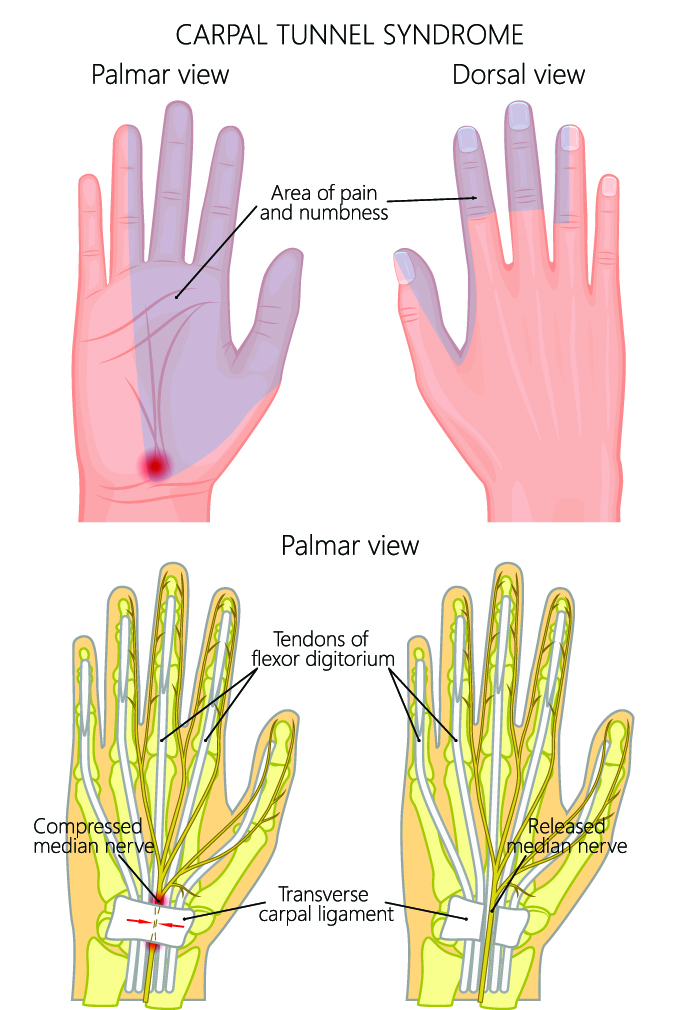Carpal tunnel syndrome: everything there is to know!
Published Aug 4, 2023 • By Claudia Lima
Carpal tunnel syndrome (or CTS) is a common hand disorder, caused by compression of the median nerve in the wrist. It is a painful pinch that can be quite disabling in everyday life.
What are the possible causes of carpal tunnel syndrome? What are the signs and symptoms? How can they be relieved and treated?
Find all the answers in our article!

What is carpal tunnel syndrome?
Carpal tunnel syndrome (CTS) is a common and benign rheumatological disorder of the upper limb. It is a musculoskeletal disorder.
It is caused by the compression of the median nerve as it passes through the carpal tunnel in the wrist. The median nerve is a sensory-motor nerve of the front of the forearm and the hand. The carpal tunnel is an osteo-fibrous communication canal between the forearm and the hand, located in the central palmar part of the wrist.
Carpal tunnel syndrome

Source: apollospectra.com
In the US, between 1 to 5 percent of the population develop this condition at one point of their life. Women are more concerned by it than men.
The incidence of CTS increases with age, obesity, diabetes, inflammatory rheumatism and other chronic diseases. Pregnancy and wrist fractures can be the cause of very acute and disabling forms of this condition.
What are the symptoms of carpal tunnel syndrome?
The main symptoms of carpal tunnel syndrome (CTS) are pain and numbness in one or both hands, particularly at night or upon waking up in the morning. There may also be tingling, sensitivity problems and weakness in the hands.
The affected area typically involves the first three fingers of the hand, with the last two fingers being spared. Discomfort may extend up the forearm to the elbow and, very rarely, above. During the day, symptoms subside, but certain activities can reactivate them.
Repetition of certain movements or postures of the hand, as well as certain illnesses, can have an impact on the development of CTS.
What are the possible causes of carpal tunnel syndrome?
Carpal tunnel syndrome is thought to be idiopathic, meaning that there is no real cause for its onset.
However, several factors may contribute to the development of carpal tunnel syndrome (CTS):
- Hormonal and metabolic factors such as pregnancy, the menopause, hypothyroidism, chronic renal failure and diabetes. These conditions encourage fluid retention or edema, and thus narrow the carpal tunnel,
- Certain osteoarticular diseases such as rheumatoid arthritis or gout,
- Anatomical predisposition to a narrow carpal tunnel,
- Age: the flexor tendons of the fingers that cross the carpal tunnel with the median nerve increase in volume with age,
- Certain movements or postures, the daily use of the hand can generate chronic inflammation, which compresses the tendons inside the carpal tunnel, which is inextensible. These movements can be linked to specific professional activities (e.g. people working in supermarkets, cleaning services, construction, catering, etc.) or leisure activities (e.g. gardening, DIY), but also to excessive use of computers and mobile phones,
- Trauma such as a fracture or a sprain.
How can carpal tunnel syndrome be diagnosed?
The diagnosis of carpal tunnel syndrome (CTS) is based on a clinical examination of the hand and wrist. The doctor may prescribe a nerve conduction test - an electroneuromyogram (ENMG), to confirm or rule out damage to the median nerve as it passes through the carpal tunnel.
Other complementary examinations, such as X-rays and ultrasound scans of the hand and wrist, as well as blood tests, may be useful in identifying the cause or a contributing factor.
Treatment of CTS will depend on the extent of the compression, i.e. the severity of the clinical and electrical signs.
Firstly, it is recommended to eliminate or change, where possible, the factors identified as contributing to the problem (repetitive movements, static postures, etc.). If one of the factors is linked to the patient's professional activity, the patient's workstation should be adjusted.
Wearing an orthosis at night should help relieve the pain by stabilizing and securing the joint. It should be worn regularly every night for the duration of the painful CTS flare-up. Painkillers and/or non-steroidal anti-inflammatory drugs may also be prescribed.
If the symptoms become more disabling on a daily basis, corticosteroid injections may be considered. This treatment provides significant relief in just a few days, and sometimes the symptoms can completely disappear for several weeks, months or even years.
And if the pain or numbness is too intense, and the muscles atrophied or weakened, surgery is the best solution to relieve the compression of the median nerve. The surgeon can cut the fibrous bundle compressing the nerve. This operation is carried out under local anesthetic on the upper limb and is an outpatient procedure.
Alternative treatments are also available, although their effectiveness is limited:
- Application of cold,
- Exercises to stretch the wrist,
- An anti-inflammatory diet,
- Alternative medicines such as acupuncture.
Carpal tunnel syndrome is a common medical condition affecting the wrist and the hand. Early detection and appropriate treatment can prevent long-term complications. Preventive measures such as workplace ergonomics and specific exercises can be put in place to avoid the development of the condition.
Raising public awareness and understanding of carpal tunnel syndrome is also essential.
Take care!
Sources :
Le syndrome du canal carpien, santepubliquefrance.fr
Syndrome du canal carpien - Optimiser la performance du parcours, has-sante.fr
Comprendre le syndrome du canal carpien,ameli.fr
Syndrome du canal carpien - Troubles osseux, articulaires et musculaires, msdmanuals.com
5 remèdes naturels pour soigner le syndrome du canal carpien, santemagazine.fr
Comments
You will also like

What are the dangers associated with the over-the-counter sale of certain medicines?
Dec 19, 2020 • 6 comments

 Facebook
Facebook Twitter
Twitter

